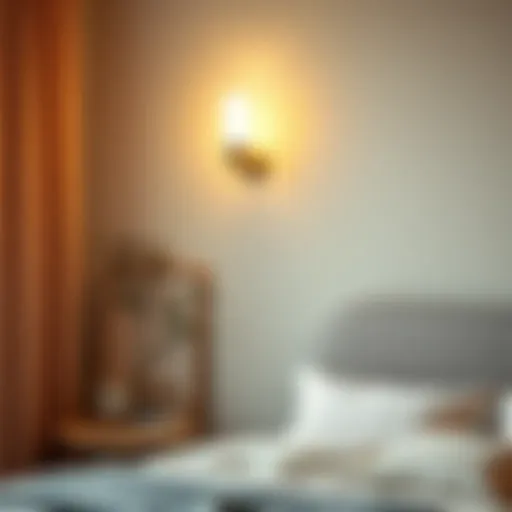Enhancing Bedroom Ambiance with Motion Sensor Light Switches
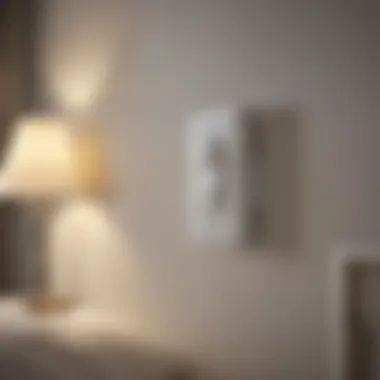

Intro
In recent years, our approach to home environments has shifted towards seeking convenience and efficiency. Among the various innovations that have emerged, motion sensor light switches stand out in transforming bedroom lighting into a smarter, more manageable experience.
This guide dives into the nuances of designing and utilizing these devices in the bedroom, focusing on their utility and the aesthetic dimensions they can bring to personal spaces. With a mix of technology and style, motion sensor light switches not only elevate the functionality of our lighting but also enhance energy efficiency and ambiance in ways that resonate with our lifestyles.
Trending Styles
Creating a harmonious ambiance in the bedroom involves not just practicality, but also an eye for design. Two prominent styles that harmonize beautifully with motion sensor light switches are Modern Minimalism and Cozy Rustic.
Modern Minimalism
Modern Minimalism embodies a sleek and clean design philosophy. Here, simplicity reigns. Think of smooth lines, understated colors, and an absence of clutter. Motion sensor switches fit seamlessly into this aesthetic. Their unobtrusive designs often feature slim profiles and neutral tones, allowing them to blend into walls or other fixtures without drawing unnecessary attention.
- Advantages: This style not only supports a tranquil environment but also promotes energy-saving features, as the lighting systems can operate on demand.
- Considerations: While choosing a switch, opt for models that come with customizable settings, matching the minimalistic ethos.
Cozy Rustic
On the flip side, we have the Cozy Rustic style, which draws inspiration from nature and traditional aesthetics. Elements like wood finishes, warm lighting, and farmhouse motifs create a welcoming space in the bedroom. Motion sensors here can be designed with natural materials or finishes that complement warm-colored walls and soft furnishings.
- Advantages: Beyond practicality, such designs evoke warmth and comfort, enhancing the room's inviting atmosphere.
- Considerations: When selecting motion sensor switches for this style, look for those that incorporate earthy tones and textures, ensuring they sync harmonously with the decor.
Color Palettes
The choice of colors can intensely influence the atmosphere of a bedroom. Selecting the right color palette enhances both emotional and aesthetic appeal and can work alongside motion sensor lighting for maximum impact.
Calming Neutrals
Calming neutrals are the backbone of many modern bedroom designs. Shades of beige, soft gray, and cream create an environment of serenity and relaxation. When paired with motion sensor lights, these shades can enhance the effects of natural light throughout the day.
- Benefits: This palette works well with adjustable lighting systems, allowing homeowners to subtly change the mood from soft morning glows to warmer evening settings.
Bold Accents
For those willing to step outside the common palette, bold accents can surprise and delight. Deep blues, emerald greens, or rich burgundies can serve as powerful focal points, especially when artfully highlighted by motion sensor lights.
- Benefits: This creates a dramatic effect, capturing attention when someone enters the room while offering a hint of elegance. Furthermore, the right light accentuates these tones, making designs pop without overwhelming the senses.
"Home is where the heart is, and thoughtful lighting choices can significantly amplify that warmth and love."
Exploring these design choices and color palettes helps decode the utility of motion sensor light switches in a bedroom context. Not only do they serve a practical function, but they also contribute significantly to the overall aesthetics and energy efficiency, paving the way towards creating inviting personal spaces.
Prologue to Motion Sensor Light Switches
As we navigate through the intricacies of modern living, the relationship between functionality and convenience becomes ever more pronounced, especially when it comes to our personal spaces like the bedroom. Motion sensor light switches represent a remarkable intersection of these two elements, transforming how we interact with lighting in environments we use daily.
These devices do more than just turn lights on and off; they embody a practical solution aimed at enhancing our everyday routines. For busy housewives and homeowners, the ease of having lights activate at the slightest movement is a game-changer. It means no more fumbling around in the dark or flipping switches when your hands are full.
Understanding Motion Sensor Technology
Motion sensor light switches utilize advanced technology to detect movement. Typically, passive infrared sensors identify body heat and trigger the lights when someone enters a room. The beauty lies in this synergy of functionality and simplicity, making the technology intuitive and user-friendly.
In addition to passive sensors, we also have ultrasonic and dual technology sensors, expanding the flexibility of lighting solutions. Ultrasonic sensors work by emitting sound waves and measuring their return; when a person enters the detection zone, the sound waves bounce back differently, activating the light. Dual technology sensors take it a step further, combining both infrared and ultrasonic methods to minimize false triggers and maximize energy efficiency.
The Evolution of Lighting Solutions
The world of lighting has come a long way. Gone are the days when a simple flip of a switch sufficed. The evolution of lighting solutions is marked by a progressive shift toward intelligent design and energy efficiency. Initially, incandescent bulbs lit our homes, which evolved into fluorescent lights, and eventually led us into the age of LED technology.
The introduction of motion sensor technology signifies another leap. Increasingly, homeowners are searching for smart solutions that not only provide lighting but also conserve energy and support sustainable living.
This evolution highlights a broader trend in home automation, where technology melds seamlessly with daily life. Now, light switches can do more than just illuminate a space; they can sense your presence, adjust brightness, and help save energy—all without the need for constant human intervention. Ultimately, they enrich our lives by providing a blend of convenience, efficiency, and modern aesthetics that compliments any bedroom decor.
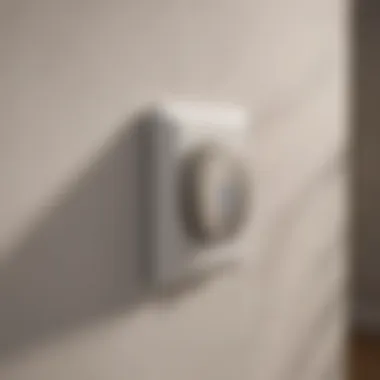

Benefits of Motion Sensor Light Switches in the Bedroom
Motion sensor light switches are more than just a novel gadget; they are an enhancement to everyday living. In a bedroom setting, where comfort and tranquility reign supreme, these devices hold importance that can't be overstated. Homeowners seeking to transform their living spaces into unique environments find these switches to be particularly beneficial. Not only do they add a layer of modern sophistication, but they also elevate convenience, optimize energy use, and enhance safety.
Enhanced Convenience
Imagine a situation where you're cozily tucked in bed, only to realize you left the light on. Many people often find themselves fumbling through the dark, searching for a light switch. This is where motion sensor switches shine. They offer an effortless approach to lighting. With the ability to detect movement, these switches turn on automatically when you enter the room, eliminating the need to stretch or even get out of bed.
Additionally, these devices can be programmed to turn off after a set period once you leave the room. This feature prevents lights from being left on, thus easing the homeowner's mind about energy waste. The simplicity of walking into a room and being greeted by soft illumination delivers a sense of comfort and ease that traditional switches simply cannot match.
"In a world that demands constant engagement, motion sensor light switches are a welcome relief from the mundane tasks of everyday life."
Energy Efficiency
In today's world, being energy conscious is not just a fad; it's a necessity. Motion sensor light switches come packed with energy-saving features that make them a wise choice for eco-minded individuals. The way they work ensures that lights are on only when needed. According to various studies, homes equipped with these switches often see a noticeable reduction in electricity bills.
Furthermore, their advanced technology allows homeowners to take control of their energy consumption.
- Automatic turn-off: Lights switch off when no movement is detected, which can significantly reduce energy usage during the night.
- Timer settings: Many models come with customizable settings, allowing users to define how long the lights stay on post-activation.
Thus, these devices not only serve as a practical solution to lighting but also reduce the strain on both your wallet and the environment.
Improved Safety
Safety is always a priority, especially in personal spaces like the bedroom. Motion sensor light switches enhance safety by brightening up the space as soon as someone enters. This is particularly useful during nighttime when visibility is limited. A sudden burst of light can help prevent accidents, such as tripping over shoes left by the bedside or navigating through clutter in the dark.
In homes with children or elderly family members, these switches provide peace of mind for caregivers. They reduce the risk of falls, helping everyone feel secure and confident as they move about. Additionally, with improved visibility comes the benefit of deterring potential intruders. A well-illuminated area is less inviting to unwanted guests.
Combining these benefits, motion sensor light switches create a safer and more pleasant atmosphere conducive to relaxation and restful sleep. By opting for this modern solution, homeowners can strike a balance between function and aesthetics, serving their lifestyle needs while ensuring comfort and security.
Choosing the Right Motion Sensor Light Switch
Selecting an appropriate motion sensor light switch is not merely about picking a gadget off the shelf; it's a process that factors in both personal needs and the unique characteristics of the bedroom environment. Different types of motion sensors serve varied purposes, and understanding them assists homeowners in making an informed decision. In essence, the right choice can enhance convenience, ensure energy savings, and provide optimal safety. Let's break it down into its components.
Types of Motion Sensors
Passive Infrared Sensors
Passive infrared sensors, or PIR sensors, are the usual suspects in homes today. They detect the heat emitted by the human body, triggering the light when motion is sensed. A key characteristic of PIR sensors is their accuracy in identifying movement, making them a solid choice for bedroom environments. Their unique feature is their capability to cover a wide detection range, typically up to 30 feet, depending on the model.
Because of their passive nature, these sensors require less power compared to others, leading to energy-efficient options. However, one must be mindful of their limitations; they can be less effective in rooms with varying ambient temperatures or if obstructed by physical barriers.
Ultrasonic Sensors
Ultrasonic sensors operate differently by emitting ultrasonic waves and detecting changes in the frequency as something moves through the space. One of their standout characteristics is their ability to detect even the slightest movements, which can be crucial in bedrooms where people may shift positions while sleeping. This feature makes them a popular option for many homeowners.
With their greater sensitivity, they do come with a downside; they can be triggered by pets or even small movements in the room, leading to unnecessary activations. So, homeowners with furry companions might need to weigh this factor carefully.
Dual Technology Sensors
Combining the best of both worlds, dual technology sensors integrate both passive infrared and ultrasonic technology. This combination allows for a nuanced approach to detection. The key characteristic is their ability to reduce false positives, enhancing reliability. Since they require activation by both technologies, the chance of accidental trigger lowers significantly. This makes them beneficial for bedrooms, adding to the overall peace of mind. However, these sensors can come at a higher cost, and their installation may require a bit more expertise compared to individual systems.
Considerations for Bedroom Use
Room size and layout
When choosing a motion sensor light switch, understanding the bedroom's size and its layout is vital. A larger space might require multiple sensors to ensure a seamless light experience. The key characteristic here is the placement; sensors must be installed in a way that optimizes their function.
A unique feature to note is the detection angle. Most PIR sensors come with about 90 degrees of coverage, which may warrant additional units in larger rooms or those with obstructions. Properly considering the size and layout means fewer inconveniences, leading to better overall satisfaction with the installation.
Lighting needs and preferences
The bedroom's lighting needs can vary significantly from one individual to another. Some people prefer a dim glow for night-time accessibility, while others might want a bright light when entering. This consideration has a pivotal role in how a motion sensor light switch is selected.
A unique feature is the ability of many sensors to adjust light levels. Some models even allow customization through mobile apps, providing flexibility based on personal habits. By carefully understanding these preferences, homeowners can choose a sensor that aligns perfectly with their lifestyle, ultimately creating a harmonious environment.
Selecting the right motion sensor light switch is a blend of technology and personal preference. With the right choice, the comfort of a well-lit bedroom can be just a step away.
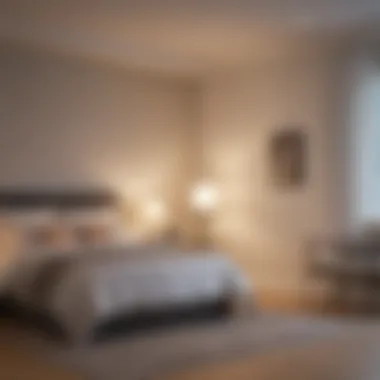

Installation Process
The process of installing motion sensor light switches in the bedroom is not just about wiring them up and flipping a switch. It's a blend of practical benefits, aesthetic choices, and technical nuances. When done correctly, the installation enhances the convenience and functionality of your space. As technology weaves its way into our daily lives, understanding the steps involved in installing these switches becomes essential for any homeowner or housewife aiming to elevate their bedroom lighting experience. The proper installation of motion sensors ensures they work reliably, serve their intended purpose, and even blend seamlessly with the existing decor.
Tools Required
Before diving into the nitty-gritty of installing a motion sensor light switch, it's crucial to gather the right tools. Not having the proper tools can be like trying to cook a gourmet meal without the right utensils. Here’s what you typically need:
- Screwdriver set: Both flathead and Phillips screwdrivers will be necessary.
- Wire strippers: For stripping the wires without damaging them.
- Voltage tester: To ensure no live wires are present before starting work. Safety first!
- Drill: Needed if you're mounting the sensor or the switch at a location that requires fastening.
- Level: To ensure the switch is mounted straight.
- Electrical tape: Useful for securing connections.
- Pencil and tape measure: To mark where the switch will go or measure distances.
Having these tools at the ready will streamline the installation process and make it much smoother. If you're missing one or two, it's wise to pick them up beforehand to avoid a mid-project run to the hardware store.
Step-by-Step Guide to Installation
Installing a motion sensor light switch can sound daunting for those not experienced in electrical work. However, breaking it down step-by-step makes it manageable for even a novice. Here’s a concise guide to help you through the installation:
- Turn Off Power: Start by switching off the power to the existing light switch at the breaker box. This step is non-negotiable for safety.
- Remove Existing Switch: Remove the plate cover and unscrew the switch from the wall. Carefully pull it out, exposing the wires behind it.
- Label Wires: As you disconnect the wires, take a moment to label them. This will help you remember where each one goes on the new motion sensor switch.
- Connect Motion Sensor: Take your new motion sensor switch and connect the wires accordingly. Typically, you'll connect the line wire, load wire, and ground wire. Follow the manual that came with the switch for specific instructions.
- Secure Everything: Once the wiring is completed, carefully tuck the wires back into the box and secure the switch with screws. Ensure everything is tight and safe.
- Replace Cover Plate: Put the cover plate back on and ensure all screws are tightened.
- Turn Power Back On: With the installation complete, switch the power back on at the breaker. This is the moment you see if all your hard work pays off.
- Test the Sensor: Walk into the room to trigger the sensor and confirm it's working properly. Adjust sensitivity or timer settings as necessary, often done via knobs or buttons on the unit.
Proper installation not only ensures safety but also allows homeowners to reap the full benefits of energy savings and convenience that motion sensor light switches provide.
Following these steps will leave you with a functioning motion sensor light switch, ready to illuminate your bedroom on its own terms.
Design and Aesthetic Considerations
Design and aesthetic choices are not just about looks; they encompass the essence of how motion sensor light switches particularly enhance and complement a bedroom's overall vibe. In any home, the bedroom is a personal sanctuary where comfort and style merge seamlessly. Having a well-designed motion sensor switch can enhance the room's functionality while also contributing to its aesthetic appeal.
A few factors come into play when considering the design of these light switches, such as style variations, fixture compatibility, and how well they resonate with existing decor. These aspects create a harmonic balance that not only serves a practical purpose but also enhances the visual beauty of the personal space.
Style Variations
Modern Designs
Modern designs of motion sensor light switches tend to focus on sleek lines and functional form. One significant aspect of modern designs is their minimalistic approach. These switches are typically available in a range of neutral colors like white, black, or silver, allowing them to blend in effortlessly with the surrounding decor.
A key characteristic of modern designs is their incorporation of smart technology, which allows for customization and integration with home automation systems. When one can control lighting through mobile apps or set preferences via voice commands, that's a game changer. This tech-savvy feature is what makes them a sought-after choice in contemporary homes.
However, the downside can often be their price point. Typically, these modern switches come at a higher cost compared to more traditional options. Nevertheless, for those inclined towards tech and modern aesthetics, the unique features outweigh the expense.
Vintage Styles
On the flip side, vintage styles ooze charm and nostalgia. These designs often capture the essence of earlier eras, featuring ornate details and richer colors. One of the standout aspects of vintage motion sensor switches is their ability to evoke feelings of warmth and comfort.
A significant trait defining these switches is the use of materials like brass and wood, which can produce a more inviting atmosphere in a bedroom. They tend to be less common in modern homes but can be a unique statement piece, effortlessly elevating traditional or rustic decor themes.
The downside here? Vintage switches might lack advanced features like wireless connectivity and smartphone controls. They're primarily functional switches that might not align with the seamless convenience the latest tech offers.
Minimalist Approaches
Minimalist approaches to motion sensor light switches cater to those who believe less is more. This style is all about function without excess visual support. A minimalist switch is often unassuming and tends to focus on clean aesthetics. The essential design ensures that the switch doesn’t distract from the bedroom's intended look and feel.
Characteristic elements of minimalism include straightforward shapes and a simple color palette. These switches often come with basic functionality, enabling them to work side-by-side with other minimalist furniture pieces. Ideal for small spaces, they can contribute significantly to creating a calming atmosphere. However, the lack of advanced technology might make them less appealing for those accustomed to more modern features.
Fitting with Bedroom Decor
Fitting a motion sensor light switch with bedroom decor goes beyond mere compatibility; it merges the practical with the aesthetic. Consider how a switch would harmonize with the color scheme, furniture, and overall design of the bedroom. It makes sense to select a switch that does more than merely function—it should enhance the visual story of the space as well.
"The best design is the one that blends seamlessly into your space, serving its purpose unobtrusively while adding to the overall aesthetic."
Creating a cohesive look involves paying attention to textures and finishes on the switch. For example, a matte black finish might pair well with industrial decor, while polished chrome aligns beautifully with a more luxurious setup.
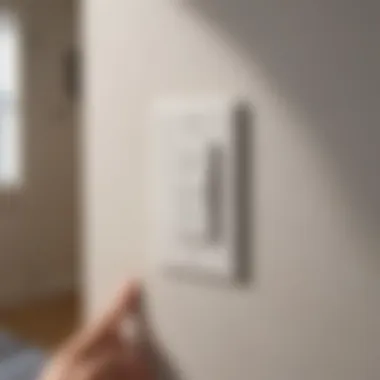

In summary, thoughtfully selecting and installing a motion sensor light switch can significantly affect both the utility and aesthetics of a bedroom, ensuring functional beauty that resonates well with individual style.
Potential Issues and Solutions
When enhancing your bedroom with motion sensor light switches, understanding potential issues is just as crucial as appreciating their benefits. These devices not only bring modern convenience and energy savings, but they also come with their fair share of challenges. Knowing what pitfalls to watch out for can save you time, keep your frustration levels in check, and ensure a smoother installation and operational experience.
Common Challenges
In the context of motion sensor light switches, several common challenges may arise that can affect functionality and user satisfaction. Here are a few that often crop up:
- False Triggers: One of the main headaches homeowners face is the switch activating when it shouldn’t. This can be due to pets, moving branches outside, or even drafts. It’s as if the sensor has a mind of its own!
- Range Limitations: Motion sensors have specific detection ranges, which can lead to dark spots in a room if not properly installed. This can leave you fumbling around for a light switch.
- Sensitivity Settings: Often, these sensors have adjustable sensitivity levels, which can be tricky to calibrate. Too sensitive, and you might find yourself lit up while watching a film, and too insensitive can lead to them not activating when you need them.
- Power Issues: Commonly, problems arise from fluctuating power sources or insufficient wiring. Lights may flicker or refuse to switch on altogether, creating a less-than-ideal atmosphere.
These challenges, while significant, are not insurmountable. Understanding them is a stepping stone to finding solutions that work best for your unique space and needs.
Troubleshooting Tips
Even the best tools can misbehave from time to time. Here are some practical troubleshooting tips that can help handle the potential issues associated with motion sensor light switches:
- Adjusting Sensor Placement: If your lights activate frequently without reason, consider relocating the sensor. It may be catching unintended movements from outside or in your room.
- Calibrating Sensitivity: Spend a little time tweaking the sensitivity settings. Most models feature a dial or switch to modify this. Experimenting can help find that sweet spot.
- Wire Checks: Ensure all connections are tight and there’s no exposed wiring. It’s a wise idea to consult with an electrician if you're unsure about the wiring situation.
- Resetting the Switch: In many cases, just turning the power off for a few minutes and then turning it back on can do wonders. It’s akin to giving your device a little breather.
- Regular Maintenance: Dust and debris can obstruct sensors. Regular cleaning can keep your lights performing optimally without the added hassle of unexpected surprises.
Future Trends in Motion Sensor Technology
As we look ahead, the evolution of motion sensor technology is shaping the future of lighting, particularly in spaces like the bedroom. The integration of advanced technologies is making these devices more versatile, energy-efficient, and seamless in our daily lives. Understanding these trends becomes crucial for homeowners and housewives aiming to enhance their personal spaces with intelligent solutions.
Integration with Smart Home Systems
Among the most significant trends is the integration of motion sensor light switches with smart home systems. Many modern homes incorporate smart technology, allowing users to control lighting remotely through their smartphones or voice assistants like Amazon Alexa or Google Assistant. The benefits are numerous:
- Remote Accessibility: Homeowners can adjust their lighting even when they are away, providing peace of mind and convenience.
- Customization: Users can set specific lighting schedules based on their lifestyle needs—dim lights for relaxation or bright illumination for reading.
- Energy Management: With these systems, users can monitor energy consumption trends, helping them to conserve power better.
The interconnectivity offered by smart home integration transforms typical light switches into comprehensive management solutions for bedroom ambiance. As more devices become compatible with these systems, the possibilities will expand significantly. Sleep modes, automatic adjustments based on occupancy, and adaptive light settings guided by environmental conditions are merely the beginning.
Sustainability and Energy Innovations
Closely related to the smart integration trend is the increased focus on sustainability and energy efficiency. Recent innovations have streamlined the energy usage of motion sensor light switches, ensuring they consume less power without compromising functionality.
Key considerations in energy innovations include:
- LED Technology: Many modern motion sensors are being paired with LED lights, which are not only long-lasting but also consume significantly less energy compared to traditional incandescent bulbs.
- Smart Sensors: Integrating sensors that differentiate between natural and artificial light means they can optimize their usage. They activate only when necessary, effectively reducing wasted energy.
- Solar Power Options: Some brands are even exploring solar-powered options for outdoor motion sensor lights, promoting sustainability further.
When paired with smart technology, these energy innovations promote a greener lifestyle by ensuring that lights are utilized only when needed, charting a path towards environmentally-conscious living.
"Incorporating these advanced features not only enhances home comfort but also reinforces a commitment to sustainability—one switch at a time."
By keeping an eye on these future trends, homeowners can make informed choices about upgrading their lighting systems, ensuring that their bedrooms not only look good but also contribute positively to the environment. As technology advances, the role of motion sensors in modern living will only grow more significant.
Closure
In closing, the integration of motion sensor light switches in bedrooms represents a significant advancement in both practical lighting solutions and enhanced living environments. This article underscores several key elements surrounding the functionality and design of these modern devices. First and foremost, their convenience cannot be overstated. Imagine walking into a dark bedroom and having the lights automatically brighten your space without a flick of a switch. This feature alone has the potential to dramatically improve the experience of using your bedroom, especially during those groggy nights when you might struggle to locate the light switch.
Next, when considering energy efficiency, motion sensors stand out. They’re designed to prevent lights from burning unnecessarily, leading to tangible savings on electricity bills. Reducing wastage not only lightens the load on your wallet but aligns with broader environmental goals, making this an astute choice for eco-conscious homeowners. Furthermore, the emphasis on safety cannot be neglected. By illuminating your path, motion sensors help prevent accidents and provide a sense of security, especially in a nighttime setting.
There are also design aspects to take into account. The aesthetics of motion sensor light switches can cater to a range of personal styles, allowing them to blend seamlessly into various bedroom decors. Homeowners no longer have to sacrifice style for function; today’s options offer both in abundance.
"Smart choices in lighting can transform not just how a room looks but how it feels and functions fundamentally."
Ultimately, as this article covered, the utility of motion sensor light switches transcends mere convenience. They embody a harmonious blend of modern technology and thoughtful design, enhancing our spaces and daily lives in ways that are often overlooked.
Recap of Key Points
- Convenience: Automatic functionality eliminates the hassle of manual switches.
- Energy Efficiency: Sensors help cut down on electricity costs by ensuring lights are used only when needed.
- Safety: Enhanced illumination reduces the risk of accidents during nighttime.
- Aesthetic Appeal: A variety of styles that fit well with different bedroom layouts.
The Role of Motion Sensors in Modern Living
The rise of motion sensors signifies more than just a trend—it's part of a greater shift toward smarter living environments. These devices are paving the way toward cohesive smart home solutions, where everything works together fluidly. Imagine a scenario where your bedroom lights interact with smart blinds, adjusting based on natural light conditions and occupancy.
In this ever-evolving landscape, homeowners are more attuned than ever to how technology influences our everyday experiences. The comfort and efficiency provided by motion sensor lights serve as a microcosm of what the future holds; a blend of convenience, energy conservation, and personalized living conditions. As we embrace these innovations, our homes can evolve into spaces that reflect our lifestyles and values, preparing us for the demands of modern life.







